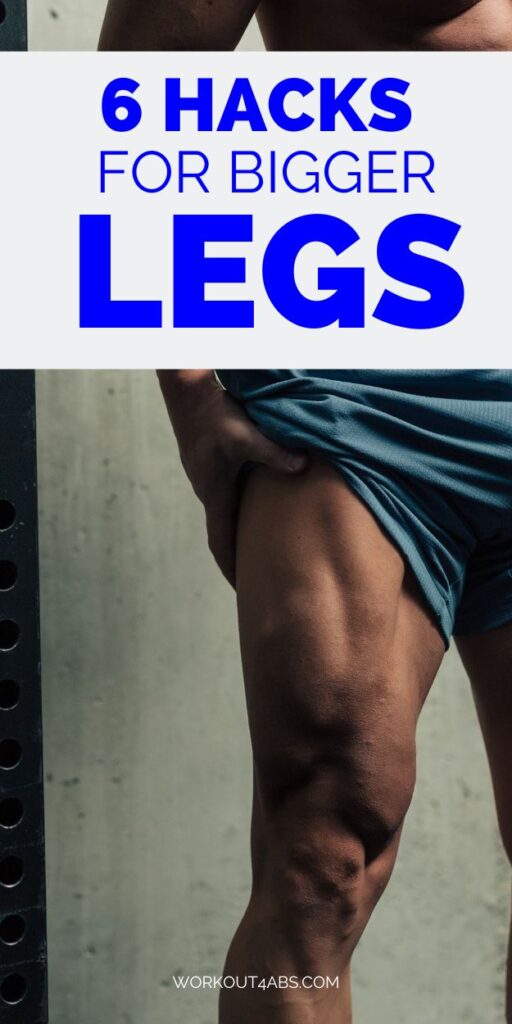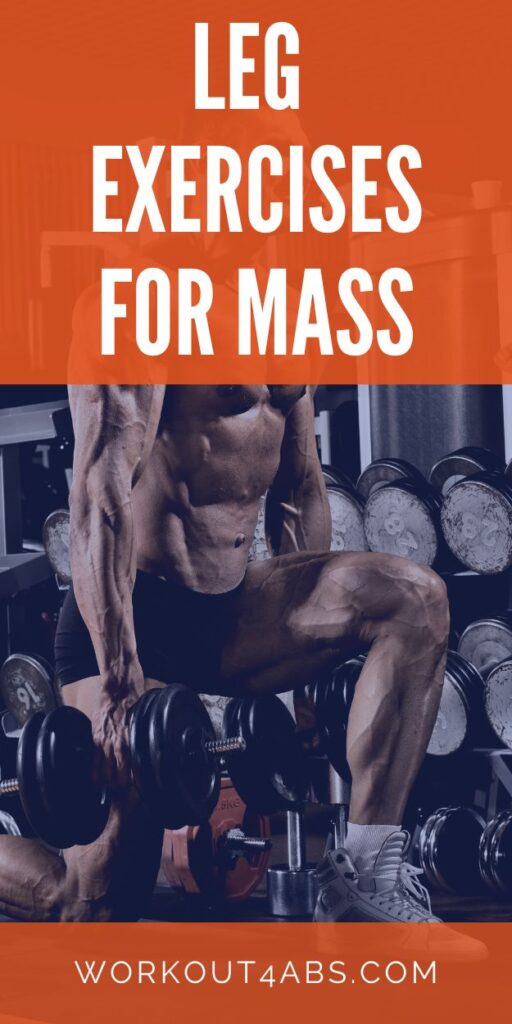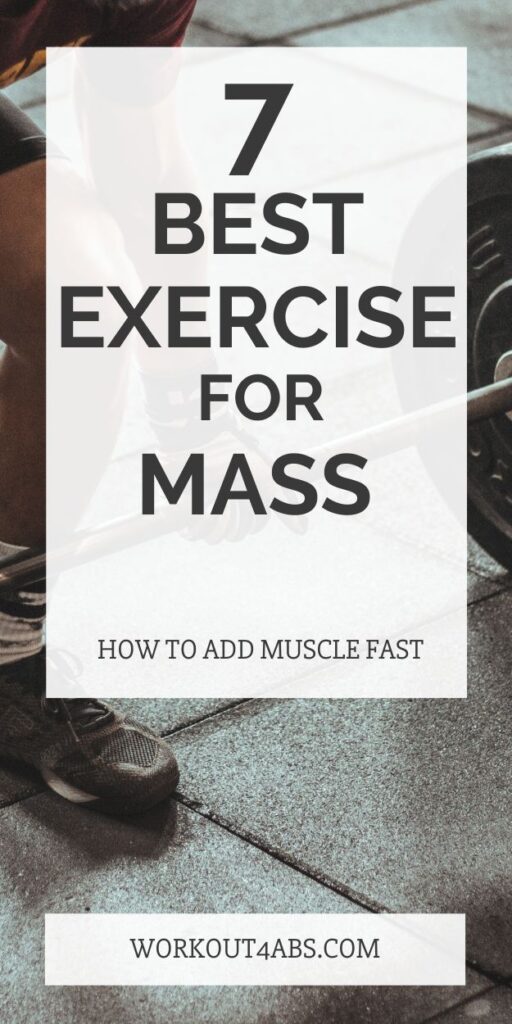You’re about to discover how to gain leg muscle fast! Are you frustrated with the lack of progress in your leg muscle growth? Despite your efforts, there might be underlying factors holding you back. In this article, we delve into five common reasons – from workout program pitfalls to cardio and exercise selection – that could be hindering your leg gains.
If you enjoyed these tips, please save this pin to your Pinterest Board.

You Likely Need to Change Your Workout Program
The common mistake of not including enough lower body exercises in a bodybuilder’s workout program can lead to imbalanced muscle development, hindered overall progress, and potentially increase the risk of injury. This imbalance can stem from several factors:
- Aesthetic Bias: Many individuals, particularly beginners, tend to focus on muscles that are more visible or socially emphasized, such as the chest, arms, and shoulders. The desire for a well-defined upper body might lead them to neglect lower body exercises.
- Perceived Difficulty: Lower body exercises can be physically demanding and challenging. Squats, deadlifts, lunges, and leg press exercises require a lot of effort and can cause discomfort. This can discourage individuals from incorporating these exercises into their routine.
- Misguided Priorities: Some bodybuilders believe that building an impressive upper body is more important for aesthetics, and they might downplay the significance of lower body muscle development. This perspective overlooks the fact that balanced muscle development enhances overall symmetry and posture.
- Time Constraints: Workouts can be time-consuming, and some individuals may skip or rush through lower body exercises to save time. This compromises the effectiveness of their lower body training and reinforces the imbalance.
- Lack of Education: Beginners might not be aware of the importance of lower body exercises or the potential negative consequences of neglecting them. Without proper guidance, they may not understand the need for balanced muscle development.
- Failure to Engage Core Muscles: Lower body exercises often engage the core muscles as stabilizers. Neglecting these exercises can lead to underdeveloped core muscles, which are crucial for overall strength and stability.
- Limited Equipment Access: Some individuals may not have access to the necessary equipment for effective lower body exercises, which can discourage them from including these movements in their routine.
- Ego Lifting: People might prioritize lifting heavy weights to showcase strength, and since lower body exercises can be challenging, they might avoid them to maintain their ego-driven lifting reputation.
- Neglecting Functional Strength: Lower body exercises contribute significantly to functional strength, which is essential for everyday activities and sports performance. Neglecting lower body training can lead to a lack of functional fitness.
To avoid the mistake of underemphasizing lower body exercises, it’s essential to create a balanced workout program that targets all major muscle groups. Incorporate a variety of lower body movements, such as squats, lunges, deadlifts, leg presses, and calf raises, into your routine. Prioritize proper form and gradually increase weights and intensity over time. Remember that balanced muscle development not only enhances aesthetics but also promotes overall strength, stability, and functional fitness. If you’re uncertain about how to structure your workout, consider seeking guidance from a fitness professional or personal trainer.
If you enjoyed these tips, please save this pin to your Pinterest Board.

Don’t Use the Wrong Combination of Exercises
Choosing the wrong combination of exercises can hinder leg muscle growth by failing to adequately target and stimulate the various muscle groups within the legs. To create an effective leg workout, it’s essential to understand muscle anatomy, muscle function, and exercise selection to ensure that you’re engaging all the necessary muscles in a balanced and productive manner.
Muscle Anatomy and Function: The legs are composed of several major muscle groups, including the quadriceps (front of the thighs), hamstrings (back of the thighs), glutes (buttocks), and calf muscles. Each of these muscle groups has distinct functions and requires specific exercises to be effectively targeted:
- Quadriceps (Front of the Thighs): Responsible for knee extension, the quadriceps play a crucial role in movements like squats and leg presses.
- Hamstrings (Back of the Thighs): The hamstrings flex the knee and extend the hip. Exercises like deadlifts and leg curls target these muscles.
- Glutes (Buttocks): The gluteal muscles are involved in hip extension and play a key role in exercises like squats, lunges, and hip thrusts.
- Calf Muscles: The calf muscles (gastrocnemius and soleus) are responsible for plantarflexion of the ankle. Exercises like calf raises target these muscles.
Exercise Selection: To choose better exercise combinations that promote leg muscle growth, you need to consider the following factors:
- Compound vs. Isolation Exercises: Compound exercises involve multiple muscle groups and joints, making them effective for overall muscle stimulation and strength development. Squats, deadlifts, and lunges are excellent compound leg exercises. Isolation exercises, like leg extensions and leg curls, target specific muscle groups and can be used to supplement compound movements.
- Range of Motion: Exercises with a full range of motion engage muscles more effectively. For example, deep squats activate the quadriceps, hamstrings, and glutes more than shallow squats.
- Variety: Incorporating a variety of exercises prevents adaptation and keeps muscle growth progressing. Mixing up exercises also ensures that all muscle groups within the legs are targeted.
- Progressive Overload: Gradually increasing weights and intensity is crucial for continuous muscle growth. Choose exercises that allow for easy weight progression.
- Balanced Training: To prevent imbalances, include exercises that target each major muscle group in the legs. Neglecting any muscle group can lead to uneven development and potential injury.
- Individual Factors: Consider your fitness level, any existing injuries, and personal preferences when selecting exercises. Certain exercises may be more suitable or effective based on your unique circumstances.
By understanding muscle anatomy and function, you can make informed decisions about exercise selection to create a balanced and effective leg workout. Incorporating a mix of compound and isolation exercises, focusing on full range of motion, and gradually increasing weights will help you target all major leg muscles for optimal growth. Moreover, a well-rounded leg workout not only enhances muscle development but also contributes to overall strength, stability, and functional fitness. If you’re uncertain about exercise selection, consulting a fitness professional or personal trainer can provide valuable guidance tailored to your goals and needs.
If you enjoyed these tips, please save this pin to your Pinterest Board.

Don’t Chase the 1 Rep Max
Focusing solely on increasing your one-repetition maximum (1RM) for squats as a strategy to build bigger legs can be a mistake due to several reasons:
- Limited Stimulus: While lifting heavy weights is important for building strength, relying solely on 1RM progression can limit the overall stimulus your muscles receive. Muscle growth (hypertrophy) is best achieved through a combination of moderate to heavy weights and higher rep ranges.
- Incomplete Muscle Activation: Squatting at or near your 1RM may compromise your form and range of motion in pursuit of lifting heavier weights. This can lead to inadequate activation of all the target muscle groups. Effective muscle growth requires proper exercise execution with a full range of motion to engage muscles optimally.
- Higher Injury Risk: Attempting 1RM lifts frequently can increase the risk of injury. Lifting near maximal loads places a tremendous amount of stress on your joints, ligaments, and muscles, making you more susceptible to injuries, especially if form breaks down under heavy weights.
- Neglecting Other Rep Ranges: Muscle growth occurs across a spectrum of rep ranges, from lower reps with heavy weights to higher reps with moderate weights. Focusing exclusively on low-rep, high-weight sets can neglect the benefits of hypertrophy that come from higher-rep sets with moderate weights.
- Lack of Volume: Building muscle requires an adequate volume of training, which involves the total amount of weight lifted across all sets and reps. Focusing solely on heavy 1RM attempts can lead to a lower overall training volume, limiting the potential for muscle growth.
- Plateauing Progress: Progressing in terms of 1RM can eventually plateau, making it harder to continue seeing improvements. Incorporating a variety of rep ranges and exercises provides a more well-rounded approach to progressive overload, leading to consistent muscle growth.
- Imbalanced Development: Relying solely on heavy squats for leg development can lead to imbalances in muscle growth. Different rep ranges and exercises allow you to target various muscle fibers and angles, ensuring more comprehensive leg muscle development.
- Mental and Emotional Strain: Constantly pursuing heavy lifts for a new 1RM can create mental and emotional stress, as it requires a high level of focus and intensity. This approach may not be sustainable in the long run and could lead to burnout.
For optimal leg muscle growth, it’s important to incorporate a well-rounded approach to your training program. This includes a mix of rep ranges, exercise variations, and techniques that target your leg muscles from different angles and with varying levels of intensity. Prioritize proper form, full range of motion, and progressive overload while keeping an eye on overall volume and recovery. A balanced training approach will not only help you avoid injury but also promote consistent and sustainable muscle growth in the long term.
Do you Have Poor Cardio?
Good cardiovascular health is crucial for effectively working the legs for muscle gain, and a lack of cardiovascular fitness can indeed make the process of gaining muscle more difficult.
You don’t want cardio to be the limiting factor.
Here’s how cardiovascular health plays a role in this context:
- Improved Endurance: Cardiovascular fitness enhances your endurance and stamina, allowing you to perform leg-focused exercises for longer durations and with higher intensity. This is essential for hypertrophy (muscle growth) because increased time under tension and higher training volume contribute to muscle development.
- Oxygen Delivery: Effective cardiovascular health ensures that your heart can pump an adequate supply of oxygen-rich blood to your muscles during exercise. Muscles require oxygen to produce energy and maintain performance. If oxygen delivery is compromised, fatigue sets in quickly, hindering your ability to work your legs optimally.
- Lactic Acid Clearance: Cardiovascular fitness helps your body efficiently clear lactic acid, a byproduct of intense exercise. Lactic acid buildup contributes to muscle fatigue and can limit your capacity to perform leg exercises for extended periods. Improved lactic acid clearance allows you to push through longer sets and workouts.
- Recovery Between Sets: Good cardiovascular health enhances your body’s ability to recover quickly between sets. When working on leg muscles, shorter recovery times can lead to greater metabolic stress, a key factor in muscle growth. If your cardiovascular fitness is lacking, you might require longer rest periods, reducing the potential for effective muscle stimulation.
- Effective Training Intensity: Cardiovascular fitness enables you to maintain higher training intensities throughout your leg workouts. This is important for achieving progressive overload, a fundamental principle for muscle growth. Without the ability to sustain intensity, your muscle-building progress may stall.
- General Energy Levels: Being in good cardiovascular condition often correlates with higher energy levels and overall vitality. This translates into more productive workouts and better consistency in training, both of which are essential for muscle gain.
Conversely, if you’re not in good cardiovascular condition:
- Reduced Training Capacity: Poor cardiovascular fitness limits your ability to perform leg exercises with sufficient intensity and volume. This can hinder the muscle-building stimulus needed for growth.
- Early Fatigue: Without proper cardiovascular conditioning, you’re likely to experience early fatigue during workouts, preventing you from working your legs to the necessary degree for muscle gain.
- Longer Recovery Times: Inadequate cardiovascular fitness leads to longer recovery times between sets, reducing the metabolic stress required for muscle hypertrophy.
- Decreased Training Frequency: Longer recovery times and decreased workout capacity can lead to a lower training frequency for leg workouts, impeding consistent muscle growth.
- Inefficient Nutrient Delivery: Cardiovascular health also impacts nutrient delivery to muscles. Poor circulation can limit the supply of nutrients necessary for muscle repair and growth.
To support your muscle-building efforts, it’s important to develop and maintain good cardiovascular health through regular aerobic exercise (such as running, cycling, or swimming) and conditioning. This will provide a solid foundation for performing leg workouts with intensity, volume, and frequency necessary for effective muscle growth. Additionally, combining cardiovascular training with proper nutrition and adequate rest will create an environment conducive to maximizing muscle-building potential.
Don’t Let Your Genes Define You
Genetics certainly play a role in determining an individual’s potential for muscle growth, but it’s important to recognize that even if you aren’t genetically predisposed to naturally large leg muscles, you can still achieve significant leg muscle growth through proper training, nutrition, and mindset. Here’s how to overcome the limitations of genetics and not let them define your potential:
- Progressive Overload: Regardless of genetics, muscle growth occurs when you consistently challenge your muscles by increasing resistance or intensity over time. Focus on gradually increasing the weights you lift, the number of repetitions, or the difficulty of exercises to create a stimulus for growth.
- Optimal Nutrition: Nutrition is crucial for muscle growth. Consume enough calories and protein to support your workouts and recovery. Adequate protein intake provides the building blocks for muscle repair and growth.
- Balanced Workout Routine: Design a well-rounded leg workout routine that includes a mix of compound and isolation exercises. Compound exercises like squats, lunges, and deadlifts engage multiple muscle groups and are key for overall leg development.
- Vary Rep Ranges: Experiment with different rep ranges. While lower reps with heavier weights can build strength, incorporating moderate to higher reps with adequate weight and controlled form can stimulate muscle growth even if you’re not genetically predisposed to size.
- Consistency: Consistency is key to overcoming genetic limitations. Consistently following a well-structured workout program and maintaining a disciplined approach to training and nutrition will yield positive results over time.
- Patience: Muscle growth takes time, and results won’t happen overnight. It’s important to remain patient and committed to your goals, even when progress seems slow.
- Mind-Muscle Connection: Focus on developing a strong mind-muscle connection during workouts. Concentrate on feeling the muscles working during each repetition. This can enhance muscle recruitment and growth.
- Quality over Quantity: Instead of obsessing over the size of your legs, shift your focus to the quality of your workouts. Prioritize proper form, full range of motion, and muscle engagement, as these factors contribute to effective muscle development.
- Positive Mindset: Don’t let negative thoughts about genetics limit your potential. Develop a positive mindset and believe in your ability to make progress and overcome challenges.
- Adapt and Adjust: If certain exercises or approaches aren’t yielding the desired results, be willing to adapt and adjust your training program. Seek guidance from experienced trainers or coaches who can provide tailored advice.
- Track Your Progress: Keep records of your workouts, weights lifted, and measurements. This not only helps you track your progress but also provides motivation when you see tangible improvements.
Remember that many individuals have achieved remarkable transformations by consistently applying these principles and pushing beyond their perceived genetic limitations. Genetics may set a starting point, but hard work, dedication, and a well-informed approach to training and nutrition can help you achieve substantial leg muscle growth, regardless of your genetic predisposition.
Home › Posture Exercises ›Gain Leg Muscle